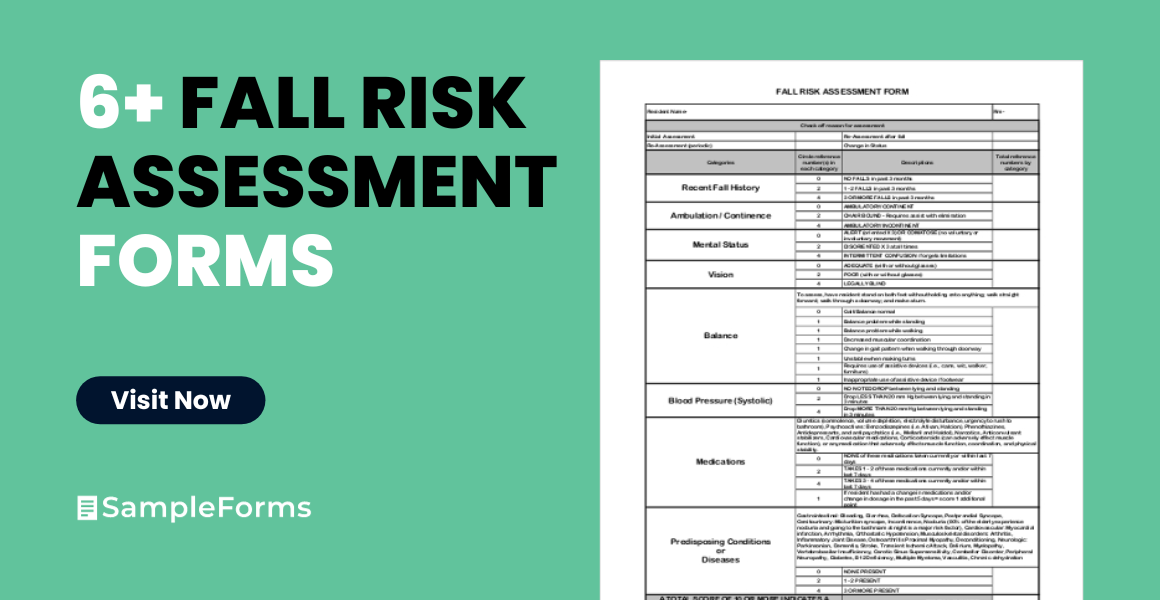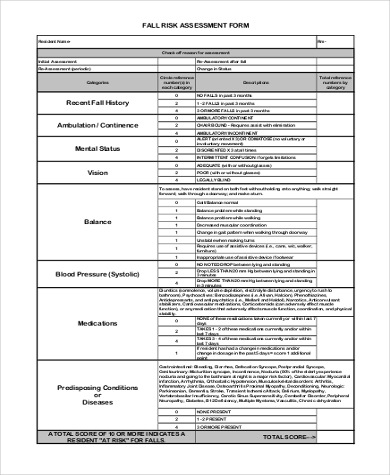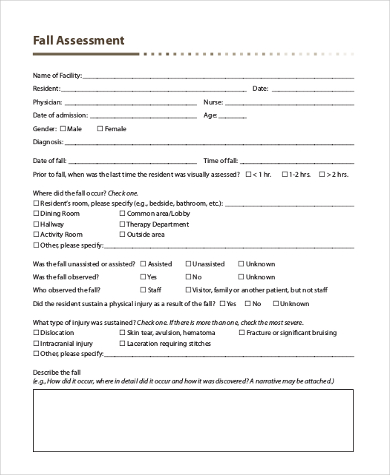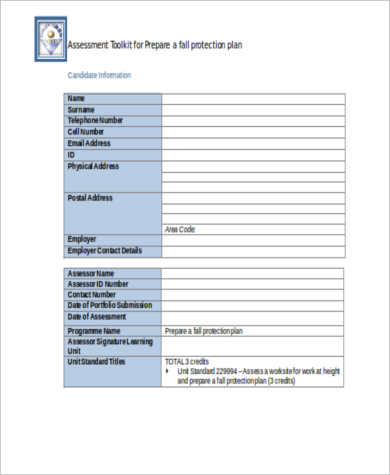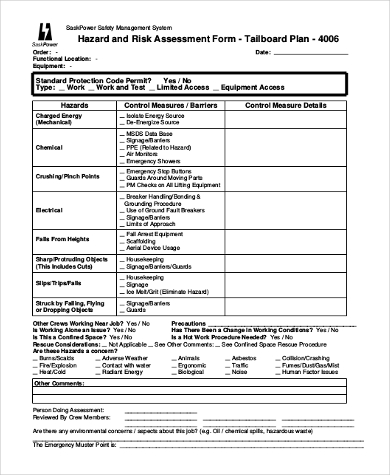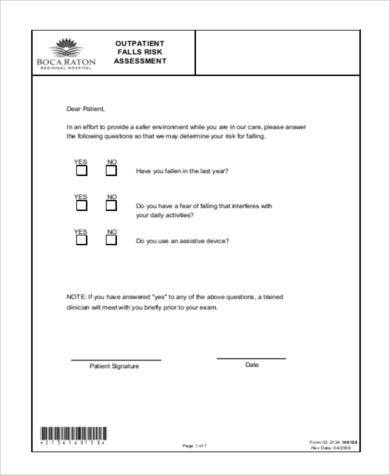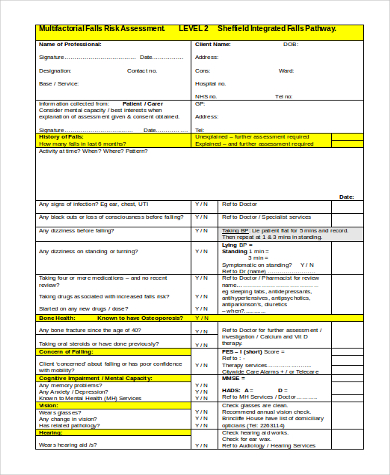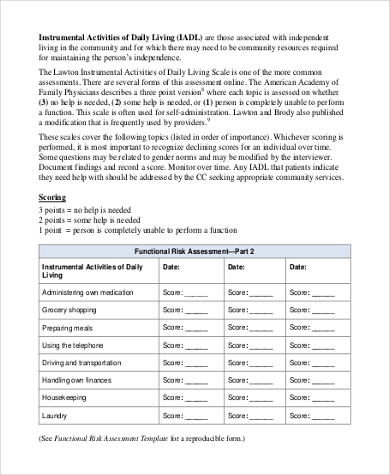A fall is when a person accidentally rests on the ground, floor, or any other lower level surface. A person is first screened if he has a high risk for falls. If found that it is so, he is then required to undergo a Fall Risk Assessment and fill out Assessment Forms to help identify the potential causes of a high risk for falls. Risk management is then implemented based on the findings of the assessment. It is usually older people and people with mobility problems who undergo this kind of assessment.
Medicare Fall Risk Assessment Form
Home Fall Risk Assessment Form Sample
Fall Protection Risk Assessment Form
The Types of Fall Risk Assessment Forms
- Medicare Fall Risk Assessment Form: A fall risk assessment is necessary for the Welcome to Medicare examination, which is a one-time physical exam performed for preventive purposes.
- Home Fall Risk Assessment Form: Thousands of older adults fall in their home each year, which is why a Home Fall Risk Assessment is necessary. This form will help you identify the hazards in your home that may result to a fall, because these hazards can be pretty easy to overlook. There will be a checklist for potential hazards found in each room of your home.
- Fall Protection Risk Assessment Forms: This is necessary when enrolling an employee in a fall protection plan, which is designed to assist employees and supervisors to identify fall hazards when working at heights. The main objective of a fall protection plan is to prevent falls.
- Fall Hazard Risk Assessment Form: This is used to identify fall hazards in the workplace, even for people who are not working at heights.
- Outpatient Fall Risk Assessment Form: This is used to assess outpatients for fall risk to determine if they need additional assistance during the duration of their visit to the hospital or clinic.
- Multifactorial Fall Risk Assessment Form: This is a comprehensive assessment of a person’s fall risk, with regard to the different factors that can cause a fall. This way, fall prevention is more specific to the factors that contribute to the risk. This is usually done for people with a high risk of falls, usually older adults.
Fall Hazard Risk Assessment Form in PDF
Outpatient Falls Risk Assessment Form
Multifactorial Falls Risk Assessment Form
Health Fall Risk Assessment Form Example
As shown in a Multifactorial Fall Risk Assessment Form, there are a lot of factors that can affect a person’s fall risk. These factors can be divided into two:
- Intrinsic: This is more on the physiology of the person, like his age, underlying medical conditions, poor eyesight, gait and mobility problems, and muscle weakness, among others.
- Extrinsic: This is more on the surroundings or environment of a person, like his home and workplace. Examples are the lack of handrails in stairwells, dim lights, obstacles and uneven or slippery surfaces, among others.
Studies have shown that fall risk management reduces the risk of falls by 30 to 40 percent. It never hurts to be aware and prepared, especially when it comes to issues concerning our health. If you are wanting to rate the performance of an employee, you may also see our Job Assessment Forms for samples.
Related Posts
-
How to Conduct a Risk Assessment? [ With Samples ]
-
FREE 4+ Sample Child Assessment Forms in MS Word | PDF
-
FREE 11+ Sample Financial Assessment Forms in PDF | MS Word | Excel
-
FREE 7+ Sample Health and Safety Risk Assessment Forms in PDF | MS Word
-
FREE 8+ Sample Supplier Assessment Forms in PDF | MS Word
-
FREE 7+ Sample Caries Risk Assessment Forms in PDF | MS Word
-
FREE 7+ Sample Management Risk Assessment Forms in PDF | MS Word
-
FREE 7+ Sample Infection Control Assessment Forms in PDF | MS Word
-
FREE 8+ Income Assessment Form Samples in PDF | MS Word
-
FREE 8+ Education Assessment Form Samples in PDF | MS Word
-
FREE 22+ Sample Self-Assessment Forms in PDF | MS Word | Excel
-
FREE 8+ Job Assessment Form Samples in PDF | MS Word
-
FREE 7+ Fall Risk Self-Assessment Forms in PDF
-
The Importance of Risk Assessment and Safety Statement [ What Is, How to Conduct ]
-
Risk Assessments And Safety Statements Guidelines [ What Is, Process ]
